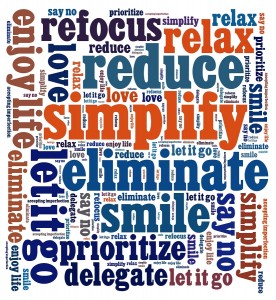 Every time I enter a client’s home, I’m reminded of the sheer amount of stuff with which we surround ourselves. Does our stuff make our lives better or more difficult? And, what happens to all of the stuff we don’t want?
Every time I enter a client’s home, I’m reminded of the sheer amount of stuff with which we surround ourselves. Does our stuff make our lives better or more difficult? And, what happens to all of the stuff we don’t want?
Most clients try to recycle as much as they can, but the truth is, much of what is donated ends up in the dump. Just this week, I was at a baby shower and the mother-to-be received so many gifts, she remarked they would need a storage unit. She wasn’t kidding.
April 22nd is Earth Day and a great opportunity to reflect on the world we would like to leave to our children and grandchildren. Take a look at the road sides as you drive around this month. Few places don’t have plastic bags blowing in the limbs of the trees and litter strewn about. While we need things to live, conduct business and improve our quality of life, do we want to leave a legacy of trash for the next generation?
Water bottles are a scourge on our earth and resources. According to Ban the Bottle, “Americans used about 50 billion plastic water bottles last year. However, the U.S.’s recycling rate for plastic is only 23 percent, which means 38 billion water bottles – more than $1 billion worth of plastic – are wasted each year.” The EPA estimates that 75% of the American waste stream is recyclable, but we only recycle about 30% of it and The Recycling Coalition of Utah states that “Americans represent 5% of the world’s population, but generate 30% of the world’s garbage.”
How can we stop burying ourselves and our loved ones in garbage?
Happy Earth Day!
Personal property is “in motion” when there is a need to deal with your movable personal possessions. Items include furnishings, art, antiques, jewelry, and collections — often referred to as “stuff.”
What puts Personal Property in Motion?
• Moving & down-sizing living space
• Selling a local home to move full-time to a vacation home
• Inheriting items when your home is already full
• Deciding to sell a personal collection
• Making a decorating/design change or upgrade
• Getting organized to deal with stuff which has accumulated over the years
• Settling an estate
Suggestions for dealing with emotions when Property is in Motion
• Pictures can help retain the memory of items. Remembering special rooms, spaces, items, and collections through picture albums can help minimize the sense of loss. The pictures, when stored and retrieved electronically, take up no physical space.
• Providing family and friends with the opportunity to acquire items helps in many cases. Passing along sentimental items, in this way, often feels good.
• Recognize it is now normal when family and friends are not interested in many of your furnishings and treasures. Unfortunately, I see this in the majority of people I have worked with in recent years. It helps to not take it personally. When this happens, it is time to sell, donate, or dispose.
Identifying and selling valuable personal property:
• Unfortunately, what you or your family paid for items does not matter to buyers.
• The buyers are generally significantly younger than the sellers. Current market value is driven by what buyers demand.
• When you look to sell valuables directly to a buyer, knowing the current market value is helpful in setting and negotiating a fair price.
• Auctions are an efficient way to deal with significant amounts of personal property in motion efficiently; there are auctions available at every level.
• Higher-end auction houses are an efficient resource in identifying valuable items and their market value; there is generally no charge for this service.
• When selling valuables at auction, it is important to use an auction house which regularly offers similar items. They will have established clientele and attract strong bidders.
Very often, a handful of the most valuable personal property items are worth as much as everything else (you’d hoped to sell) combined. When this happens, half of the financial work in handling the property in motion is complete, simply by identifying and selling the most valuable items.
The process of dealing with property “in motion” brings out emotion. There are memories attached to belongings which connect us to our family, friends, and occasions throughout our lives. While the process may have emotional ups and downs, it feels good when it is complete. I wish you well.
Click on the title above to learn more about the featured author.
Forget Google! Professional Organizers have a plethora of resources to share with you ranging from recycling centers to special events happening in your area. Here are my favorites:
Consignments shops
~The Attic, Manayunk
“Here at The Attic we aim to provide a fun and engaging environment while also offering advice on modern and vintage trends.”
4335 Main St., Manayunk, PA 19127
Phone: 215-482-0300
~Greene Street, Manayunk
“Since Greene Street opened its doors in 1997, we have been working to offer affordable fashion in a clean, organized, and modern setting.”
4313 Main St., Philadelphia, PA 19127
Phone: 267-335-5478
Donations
This is a huge store which earned the nickname the “Pechin Street Boutique.”
4555 Pechin St., Philadelphia, PA 19128
Phone: 215-483-3340
 ~Colonial Neighborhood Council
~Colonial Neighborhood Council
“Colonial Neighborhood Council operates “The Well,” a thrift store offering a household items and clothing for adults and children.”
107 E. 4th Ave., Conshohocken, PA 19428
Phone: 610-828-6595
Recycling
“Recycling Kiosks — Every U.S. Best Buy store has kiosks, just inside the front doors, to drop off ink and toner cartridges, rechargeable batteries, and wires, cords and cables, plastic bags and gift cards.”
~Whole Foods Market, Plymouth Meeting (the biggest & nicest store I have ever s een)
een)
Recycle batteries, cork, plastic bags, Brita filters, yogurt cups & plastics #5
500 W. Germantown Pike, Plymouth Meeting, PA 19462
Phone: 610-832-0010
Events
~Household Hazardous Waste Collection
Saturday, May 30- Montgomery County Community College
340 DeKalb Pike (enter campus at 595 Cathcart Road), Blue Bell, PA 19422
~Paper Shredding
Saturday, August 15 (9am – noon)- Abington Junior High School
2056 Susquehanna Road, Abington, PA 19001
~Tire Collections
Saturday, June 6- from 9:00am – noon, Montgomery County Community College
340 DeKalb Pike, Blue Bell, PA 19422
~Finally, did you know about MedReturn Drug Collection Units? There is one at  the Montgomery County Courthouse.
the Montgomery County Courthouse.
2 E Airy St., Norristown, PA 19401
Phone: 610-278-3000
Some restrictions and fees may apply. Ask the Professional Organizer you hired. They’ll know!
Whether you follow basketball or not, college ball is an exciting sport and March Madness is the be-all, end-all competition among collegiate teams. I am always inspired by the players’ drive, athleticism, and winning attitude. Borrow this enthusiasm and plan your own decluttering plays for a Spring-ready closet.

March Madness has become an annual springboard for me to declutter. I love the NCAA’s single-elimination process as a framework for purging my wardrobe.
The tournament always starts in March and concludes in April — as we warm up to Spring. I appreciate the build-up to the ultimate winner; each week there are winners (and losers). Borrow this approach and discover the winners and banish the losers in your closet.
• winners – clothes that are versatile, stylish, and flattering
• losers – anything stained, ill-fitting, or in need of repair
If you like following play-lists, here’s some quantifiable advice to help you keep score on your efforts:
• Trim 16 (Sweet Sixteen) bulky sweaters and jackets from your closet to make room for Spring styles. Scarves are typical accessories that you can rotate each season. Footwear is another category that deserves attention: pack up your heavy, weatherproof boots.
• Remove at least 8 items from your hanging space to create room for bolder colors and lighter-weight outfits. What you remove may end up in off-season storage, or may need to find a new home. Can you find an Elite Eight to donate, thrift, or E-bay?

• Final Four Here’s where the tournament makes its biggest splash and reminds me to focus on the basics. Make sure you have what you need to enter Spring, well dressed in the appropriate clothes that suit your life and lifestyle. This may mean creating a short shopping list for your foundation pieces, or a to-do list for the winners before they go on court.
• shine your shoes to clean and preserve their leather
• alter any investment pieces so you continue to enjoy them
• dry-clean items that you have enjoyed all season but are packing away until next year
The hardest lesson March Madness teaches is one-and-done. The Final Four teams play two games over three days to determine a national champion. Culling collections down to a single winner is unrealistic (I couldn’t survive with only one pair of black slacks!) Selecting winners — of a reasonable quantity — based on proven criteria is a good play.
Look around everywhere you turn is clothing
It’s everywhere that you go [look around] You try everything you can to escape
The pain of piles that you know [piles that you know]
When all else fails and you long to be
Something better than you are today
I know a place where you can get away
It’s called The Container Store, and here’s what it’s for, so…
Come on, vogue
Let your body shop to the muzak [shop to the muzak]
Hey, hey, hey
Come on, vogue
Let your body go with the flow [go with the flow]
You know you can do it!
-By Madonna, and slightly tweaked by me! ☺
So…the holidays are over now. You’ve probably returned some clothes that you received (perhaps an ugly holiday sweater) but still kept some as well. Problem though…your closet is packed and there’s no room for even one more thing!
No worries, let’s take it step by step, so you don’t get overwhelmed! Do one step a day if you need.
Step 1 – Grab a trash bag and skim through the shelves and rods, and look for any items you obviously know that you don’t like to wear anymore, even if they fit fine. Put all the items in the bag(s), which you can take to consign (if you have expensive pieces) or donate. Immediately put the bag(s) in the trunk of your car. If they stay nearby, the level of temptation to put things back will be high. That’s why many Professional Organizers will offer to take your bags for you! Well that, plus we are just nice people who like helping others!
Step 2 – Shelf by shelf and with sections of hanging, bring the clothes out and set them on your bed. You are now going to look for items that are stained or ripped and beyond cleaning or repair. Again, if you have some expensive pieces, try your hand at a dry cleaner and a tailor. Otherwise, break out another trash bag and let those items go. Temptation isn’t nearly as high for this bag, right?!
Step 3 – Aside from the clothes that you like to wear left in the closet, there are bound to be many that you still hold onto for nostalgia’s sake or because you want them for when you can fit into them again. Perhaps you’ve heard the statistic that people wear only 20% of their clothing 80% of the time. Don’t worry…I’m not going to be too hard on you here! Purchase some clear bins (perhaps at The Container Store!) that can sit on the top shelves of your closet. Those clothes will be going in there for now. You’ll still be aware that those items are there, but they won’t be taking up your valuable space. Every few months, or at least in another year, pull the bins down to gauge your feelings about the clothing inside.
Step 4 – Now’s the time for some fun! Put those new clothes on and dance around (perhaps doing the Vogue!) as if it is your own small fashion show, and celebrate the fact that you now have room for these new pieces!
Step 5 – After regaining your composure and your breath (ha ha) you can put your clothing on the many empty hangers that you have made available.
Here’s to you and a happy and clutter-free New Year!
 Typically in our society, we acquire items, things, and stuff. We use our valuable time to acquire these so called treasures. It may have felt good to collect and accumulate. Yet, when it’s out of control it appears as clutter and usually those feelings change. Overwhelm shows up. That’s the signal, the “red flag”, that it is time to take some action. One action could be evaluating and accessing the reasons you have what you have. We are not talking about items that serve a purpose, are useful, and make your life better.
Typically in our society, we acquire items, things, and stuff. We use our valuable time to acquire these so called treasures. It may have felt good to collect and accumulate. Yet, when it’s out of control it appears as clutter and usually those feelings change. Overwhelm shows up. That’s the signal, the “red flag”, that it is time to take some action. One action could be evaluating and accessing the reasons you have what you have. We are not talking about items that serve a purpose, are useful, and make your life better.
Are you holding on dearly to the “stuff” that:
1. Represents “Who” I am, or “Who” I was, or “Who” I want to become
Do you like any of these “Who’s”? Sometimes they don’t align with who you are presently, or they are reminders of the past, or even reminders of in-completions. If you don’t feel energized or happy with them, then why keep them around?
2. I may need this someday
Future thinking that could keep you up to your eyeballs in excess stuff. It could be said this indicates a lack of trust in the future. Our thoughts can create our reality. If unconsciously your thoughts are coming from a place of lack, you will create that. What do I mean? If you trust that you will have all you need , you will have it!
3. I got this as a gift
Just because your favorite person bought this doesn’t justify saving space for it if you don’t need, want, or like it. Re-gifting or donating gives it a new life from gathering dust or buried in a pile. Using places for unwanted items takes away your precious space.
4. Family relics that have been passed on to me
So maybe you have inherited these things that have no meaning or sentimental value to you. If you feel you want to memorialize the people, choose a few items and get creative. Make a shadow box or a special area to display them. If you will have joy and feel happy seeing these items in your home, then that’s what counts!
5. I feel secure having this/ Can’t have empty space
No matter how many possessions you acquire the need for more will occur. Remember to keep what makes you happy, and give away what you don’t like. If you don’t like empty space, look at why. Also keep in mind that no matter how much you have, keep these areas safe and accessible. This is your home and a place to retreat to from the outside world.
6. It cost so much/got it for free
It’s all relative to how you look at value. Whether you spent more on an item or got it for free it comes down to how you view this. When looking at an item in this category to purge or keep, check out if your beliefs or values around the money are holding you back from making the decision. This awareness may open you up to making a decision based on what you like regardless of the cost.
Looking at these categories and evaluating brings self awareness and conscious choices. This awareness can lead you to taking another step; recognizing what’s behind your decision making. If you choose to recognize these things it might set you free. One being mental clarity and then giving yourself the freedom to make a choice. The choice of physically letting items go that you don’t really want, or keeping what you truly treasure!